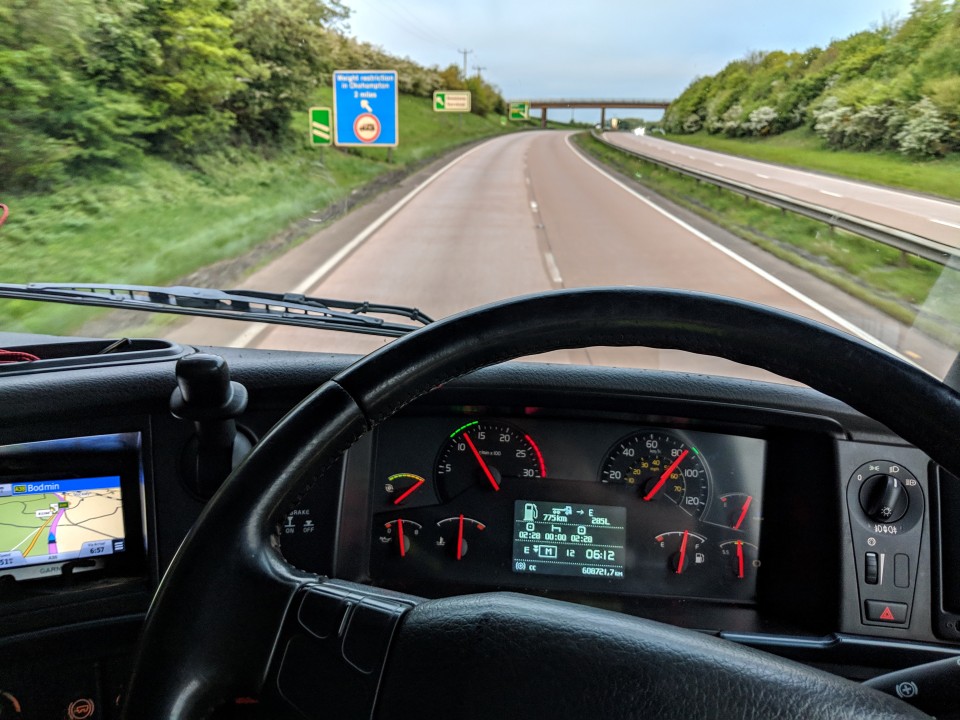
Susie Jones
Reglerne for fartskrivere gjort nemme
Oprettet: 01.08.2024
•
Opdateret: 08.08.2024
Fartskriverreglerne kan være et forvirrende sted for selv den mest erfarne lastbilchauffør. For slet ikke at tale om dem, der er nye i branchen. Vi forsøger at rydde op i noget af den forvirring.
Hvad er en fartskriver, og hvorfor har vi dem?
Ifølge ordbogen er en fartskriver "en anordning, der monteres i køretøjer som lastbiler og busser for at registrere oplysninger som f.eks. hvor hurtigt køretøjet kører, hvor langt det kører, og hvor mange pauser chaufføren holder."
Formålet med en fartskriver er at forhindre træthed hos føreren og sikre, at førere og arbejdsgivere overholder reglerne. [Trafiksikkerhedsorganisationen Brake] (https://www.brake.org.uk/get-involved/take-action/mybrake/knowledge-centre/driver-fatigue) rapporterede, at "fire ud af ti træthedsrelaterede ulykker involverer en person, der kører et erhvervskøretøj." Derfor spiller reglerne for fartskrivere en vigtig rolle i bestræbelserne på at reducere dette antal.
Hvornår har du brug for en fartskriver?
Du skal have en fartskriver, hvis din bruttovægt overstiger 3,5 ton. Det er vigtigt at huske, at dette også gælder, hvis du trækker en anhænger. Der er nogle få undtagelser fra denne regel:
Hvis du kun kører på offentlige veje
Hvis køretøjet køres af de væbnede styrker, politiet eller brandvæsenet
Hvis du er en kommerciel flåde og bruger køretøjer med en maksimal vægt på syv et halvt ton, og din rejse er mindre end 100 km fra din driftsbase.
Hvis du transporterer varer, og dit køretøj er elektrisk
Hvis du transporterer udstyr eller maskiner til brug for føreren, og det ikke er dit primære arbejde at køre dette køretøj.
Hvad er de forskellige typer fartskrivere?
Der findes tre forskellige typer fartskrivere:
Analoge: Disse blev gjort obligatoriske i Europa i 1986. Analoge fartskrivere bruger vokspapirark til at registrere førerdata. Chaufføren indtaster oplysningerne manuelt og sætter dem ind i fartskriveren.
Digital: Disse blev introduceret i 2006. De bruges af mere end en million transportvirksomheder og over seks millioner professionelle chauffører. Digitale fartskrivere registrerer førerdata på en intern lagerenhed og et førerkort.
Smart: Fra juni 2019 krævede EU, at virksomheder skulle bruge intelligente fartskrivere. De registrerer automatisk køretøjets position ved begyndelsen og slutningen af hver rejse. De giver også opdateringer hver tredje time.
Hvad betyder hvert fartskriversymbol?
Se vores [video] (https://www.youtube.com/watch?v=dgqGmlu9LfM&t=3s), der forklarer hvert tachografsymbol
Regler for pauser
Af hensyn til lastbilchaufførens og alle andre trafikanters sikkerhed skal pausereglerne overholdes. Vi har samlet de vigtigste punkter.
Køretid:
- Må ikke være længere end fire og en halv time før en pause
Pauser:
- Skal være på mindst 45 minutter, medmindre en chauffør tager et hvil.
Hvileperiode:
- Under en hvileperiode må der ikke køres eller udføres andet arbejde.
Opdeling af pauser:
En fuld 45-minutters pause kan deles op i en 15-minutters pause efterfulgt af en 30-minutters pause.
Deling af pauser skal fordeles over de fire og en halv times køretid
I henhold til EU-reglerne skal den anden pause være på mindst 30 minutter, hvis pauserne er opdelt.

Daglig køregrænse
Den daglige køregrænse henviser til den maksimale køretid i løbet af en dag. Ni timer er det maksimale, men det kan øges til 10 timer. Dette kan dog ikke gøres mere end to gange i løbet af en uge. Daglig køretid kan defineres som:
Den samlede akkumulerede køretid mellem afslutningen af en daglig hviletid og begyndelsen af den følgende daglige hviletid.
Den samlede akkumulerede køretid mellem en daglig hviletid og en ugentlig hviletid. .
Ugentlig og to-ugentlig køregrænse
Chauffører skal sikre, at de ikke overskrider den maksimale ugentlige og to-ugentlige kørselsgrænse.
Den maksimale ugentlige køregrænse er 56 timer (gælder for en fast uge)
En fast uge starter kl. 00.00 og slutter kl. 24.00 den følgende søndag.
En grænse på to ugers kørsel er 90 timer.
Daglig hvile
Derudover skal der tages daglig hvile.
Chaufføren skal have 11 timers sammenhængende hvile. Dette kan reduceres til ni
Denne reduktion kan kun ske op til tre gange mellem ugentlige hvileperioder.
Hvileperioden skal være afsluttet inden for 24 timer efter afslutningen af den sidste daglige eller ugentlige hvileperiode.
Den daglige hvile kan tages i køretøjet, men der skal være passende sovefaciliteter. Hvis disse faciliteter ikke findes, skal chaufføren selv finde overnatning. Tjek vores side locations for at finde ud af, hvilke rastepladser der tilbyder denne service.
Ugentlig hviletid
Den ugentlige hviletid skal tages senest ved afslutningen af seks på hinanden følgende 24-timers perioder fra afslutningen af den sidste ugentlige hviletid.
Chauffører skal tage mindst 45 timers hvile
De kan tage en reduceret ugentlig hvileperiode på mindst 24 timer
Reduceret ugentlig hvile skal kompenseres i en blok og mindst ni timer inden udgangen af den tredje uge.
Selvom der kan tages reduceret hviletid, er det værd at bemærke, at i to på hinanden følgende uger, hvor der er taget reduceret hviletid, skal den ene være 45 timer lang.

Multi-bemanding
Nogle chauffører kan tage en anden chauffør med om bord. Fordelene er bl.a. øget produktivitet, flere kørte kilometer og længere køretid.
Begge chauffører skal tage ni timers daglig hvile
Denne daglige hvile skal tages inden for 30 timer i stedet for 24.
Den første time med multi-manning kræver ikke en anden chauffør. Efter en time bliver det obligatorisk.
Færgeoverfarter eller togrejser
Som nævnt ovenfor skal en chaufførs normale daglige hviletid være på 11 sammenhængende timer, men der er nogle få undtagelser fra denne regel. Forudsat at køretøjet ledsages af føreren, kan den daglige hviletid afbrydes to gange, men må ikke overstige en time i alt. For eksempel ved på- og afstigning på færger og tog.
Hvis den normale daglige hvileperiode afbrydes på denne måde, skal den akkumulerede hvileperiode være på mindst 11 timer eller 12 timer, hvis den er opdelt.
Hvad er reglen om ét minut i fartskriveren?
Et-minutsreglen trådte i kraft i oktober 2011. Den henviser til ældre lovgivning, som foreskrev, at et minut med mindst fem sekunders kørsel skulle logges som køretid. Men EU ændrede denne lovgivning, så den længste sammenhængende aktivitet inden for et minut bliver logget i forhold til den specifikke aktivitet.
Hvad sker der, hvis jeg ikke følger reglerne for fartskrivere?
Manglende overholdelse af fartskriverreglerne kan resultere i bøder og nogle gange fængselsstraf. Generelt afhænger straffen af overtrædelsens alvor. De fleste overtrædelser af fartskriveren håndteres med faste bøder. Chauffører har op til 28 dage til at overveje faste bøder.
Der er to typer af bøder og straffe i Storbritannien.
Niveau fire-bøder: Disse er begrænset til £2.500; dette loft gælder for hver fartskriverbøde. Sager med flere overtrædelser på niveau fire kan dog få en maksimal bøde pr. overtrædelse.
Bøde på niveau fem: Disse er begrænset til £5.000, men ligesom med bøder på niveau fire kan sager med flere overtrædelser få den maksimale bøde.
Reglerne for fartskrivere kan være svære at finde rundt i. Men hvis man ikke følger dem, kan det føre til sikkerhedsproblemer og potentielle bøder. Ved at forstå og følge reglerne kan flåder og chauffører betjene deres køretøjer sikkert og lovligt. Det er vigtigt at bemærke, at regler og bestemmelser for fartskrivere kan variere fra land til land.



